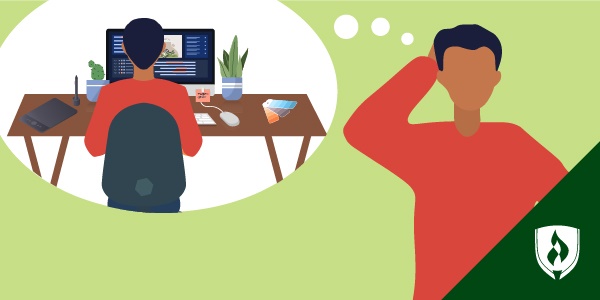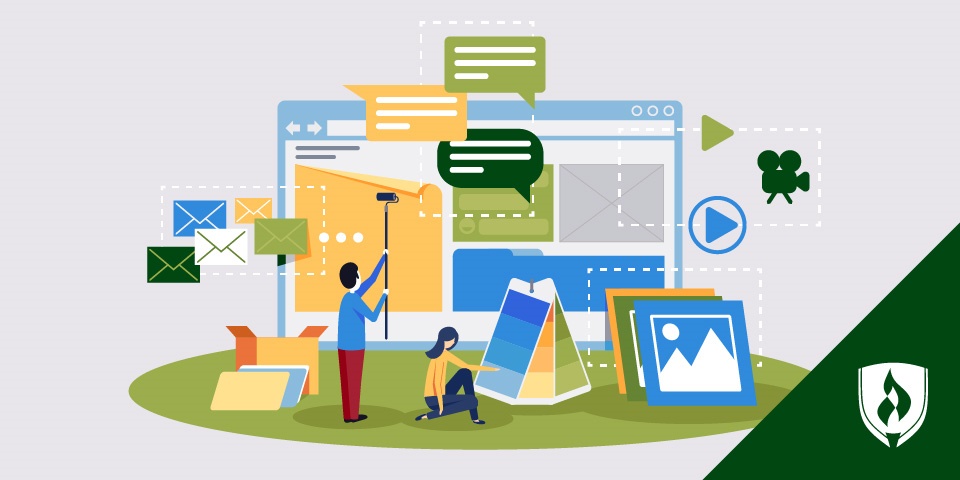
It’s not just that everyone in your family goes to you with questions about their smartphones, you’ve practically grown up online. Couple that with an eye for what’s visually appealing and it’s easy to understand why a career in web design may have caught your interest.
While this creative career might sound appealing at first thought, there’s still a lot more you like to know about the work before pursuing this field. In this article we’ll explore the typical web designer job description as well as how web designers navigate the very real challenges and opportunities in their day to day work.
A typical web designer job description
At its simplest: web designers design and create websites. But within that seemingly straightforward description is a network of technical and creative components. Web designers are responsible for the website’s visual look, technical performance and capability, and in some cases a website’s written content. Work as a web designer frequently involves strong writing, graphic design and front-end coding skills.
Web designers are both creative problem solvers and fine detail workers. In addition to the creation and maintenance of websites, web designers often work closely with other members of a creative team or directly with clients, which requires strong interpersonal skills.
Basic web designer duties
Before we get too far along, it should be noted that the role of a “web designer” can bleed over a bit into web developer, particularly front-end web development. There’s not always a clean dividing line between the two—but generally speaking web designers are the people responsible for the appearance of a website. According to the Bureau of Labor Statistics, here are some of the basic responsibilities of a web developer that align with web design:1
- Meet with clients or management to discuss the needs and design of a website
- Write code for the website, using programming languages such as HTML or CSS
- Work with other team members to determine what information the site will contain
- Work as part of a design team to determine the website’s layout
- Integrate graphics, audio and video into the website
Beyond the web designer job description: What you should know
That’s the job on paper (or on screen), but what’s the job in practice? We spoke with veteran web designers about their day to day experiences, career challenges and the most exciting parts of their work. Based on their answers, we’ve put together 6 unexpected outcomes of becoming a professional web designer.
1. No two days are the same
Web design is not the right fit for people who enjoy a repetitive schedule. The complex nature of web design requires designers to adapt to new challenges and explore innovative, out-of-the-box solutions for a wide variety of projects.
“You don’t get bored doing the same monotonous task repeatedly,” says Michael Goldstein, owner and website designer of VRG Web Design. “One day you might be creating a design for a website, the next, you are creating content for a social media campaign in a whole new industry.”
For the right kind of worker, this dynamic work style can be a steady source of inspiration that keeps your daily work interesting.
“I absolutely love the variety of work we do,” says Terry Kasdan, president and creative director of atCommunications. Kasdan transitioned into web design from working as an art director for an agency that made print ads and brochures. “One day I’ll be designing a website for a university, the next I’ll be working for a hospital, and the day after that, I’ll be working on the site for a charity foundation. Working on different projects for such a wide array of businesses and organizations really keeps the creative juices flowing.”
2. You’ll never stop learning
Design tastes change, and the web development tools and technologies needed to bring a vision to life aren’t frozen in time. That’s a big reason why “Never stop learning” is a common refrain from web design professionals. To be an effective web designer means staying current and even thinking ahead of tech trends.
“There is so much information available to consume and things change quickly all of the time,” says Jeff Romero, co-founder of Octiv Digital.
While you can’t predict the future, the best designers make a conscious effort to keep tabs on trends and changes in site layouts, user preferences and the tools used to make it all come together.
3. You are not the target audience
Every creative professional has their aesthetic preferences. Maybe you prefer bold imagery and vibrant colors, while others would see a muted minimalist approach. While these personal preferences aren’t a bad thing to have, it can be hard to separate your subjective opinions from your work.
“It took me time to realize that, sometimes, you have to create something that isn't the way you'd want it done,” says Jason David, CEO of Software Portal.
Web designers need to be comfortable with stepping outside of their own perspective and empathizing with the true audience of a site—what do they want and need to see to make their trip to this page a success? What does your client need these people to do?
“Don't ever be afraid to push the boundaries of a brief but remember that form needs to follow function,” says Claire Hindes of EIC Marketing. “A site needs to look good, but it
also needs to do its job.”
4. You might be your own boss
Have the entrepreneurial spirit? This might be the right field for you. Web design and development is a field that traditionally lends itself well to freelancing, contract work or other forms of self-employment.
“You may think you can do something better or that your way is superior, but unless you’re the boss and the one writing the checks, you don’t get the final say,” says David. “That’s why I became the boss.”
However, working as a freelancer or creating a new company requires a great deal of business savvy that shouldn’t be taken lightly.
“One thing I wish I knew when I started my career was how much more would be involved when you go out on your own as a freelancer getting web design jobs,” says Goldstein. “There is so much more business and marketing that you need to learn and become comfortable with.”
5. Your work is valuable
If you haven’t already picked up on it, web design is a field that requires a great deal of skill. To be a strong designer means you have many highly valuable skillsets and deserve compensation for the full extent of your work. Particularly for freelance web designers, accurately assessing the value of your work can be an intimidating prospect when you’re just starting out. It’s easy for designers with little professional experience to fall into the trap of undervaluing their time—but it can hurt you (and the entire field) in the long run.
“Early on in my career, I wasn’t confident in my own skills and I was scared to charge a proper price for my work,” says Kama Wilson, director of strategy and co-owner of Smitten Premium. “I wish I’d known earlier the difference that I could make in other people’s lives and focus on that rather than on my own insecurities.”
6. Accessibility matters
There are so many design, content, and technical considerations that go into web design the question of accessibility often falls through the cracks.
“It was not possible to predict how the digital world would evolve and technology would be integrated into our daily lives, tasks and routines. Having a crystal ball would have been helpful so that I could have started much earlier helping create inclusive experiences and environments for all users,” says Ash Harris, CEO of AKEA Web Solutions, which works to make web environments accessible for all users including people with disabilities.
“Technology has matured tremendously and the internet has provided a gateway for people to access the entire world. It’s time to stop excluding and failing to appropriately consider those in the disabled community. With the web, it is an opportunity for all users to participate and contribute in a way never before imaginable.”
Interested in learning more about becoming a web designer?
Does the work of a web designer still sound like it could be a good fit for you? These professionals blend creative vision with technical know-how to provide users with engaging, intuitive and aesthetically pleasing experiences online. Check out our article, "What Is a Creative Brief? An Intro for New Designers".
Want to learn more about the natural traits and tendencies you’ll need to succeed in this field? Get a better idea in our article, “Do You Have What It Takes to Become a Web Designer?”
Related Articles:
1Bureau of Labor Statistics, U.S. Department of Labor, Occupational Outlook Handbook, [accessed December, 2019] www.bls.gov/ooh/. Information represents national, averaged data for the occupations listed and includes workers at all levels of education and experience. This data does not represent starting salaries. Employment conditions in your area may vary.




